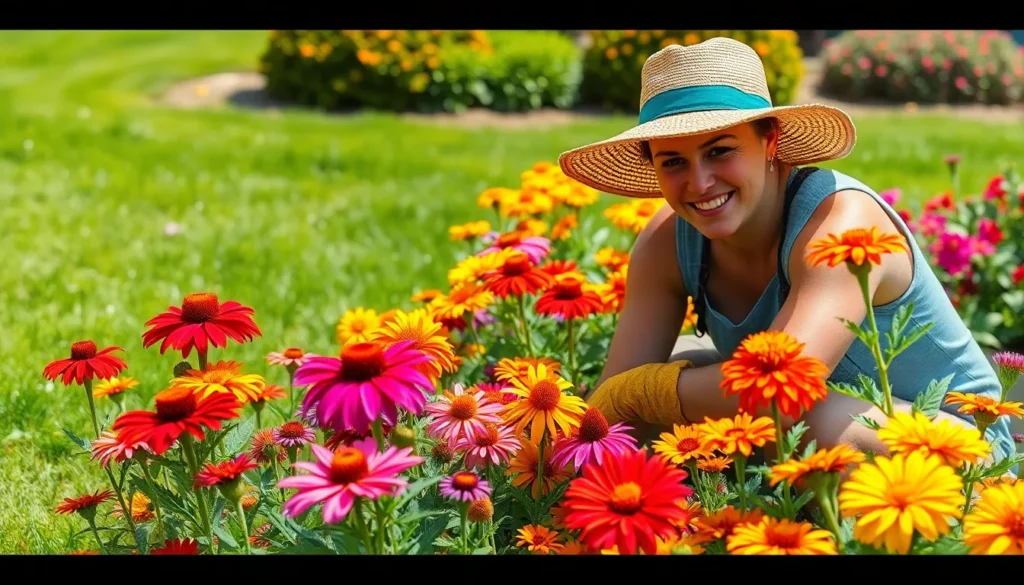When temperatures soar and the sun beats down relentlessly we know how challenging it can be to maintain a thriving garden. Many gardeners struggle with finding plants that won’t wilt under intense heat or scorching sunlight leaving them frustrated with brown patches and failed landscaping efforts.
But we’ve discovered that choosing the right heat-tolerant plants transforms your outdoor space into a vibrant oasis that actually thrives in extreme conditions. These resilient beauties don’t just survive blazing summers – they flourish and reward you with stunning blooms spectacular foliage and minimal maintenance requirements.
Whether you’re dealing with a south-facing yard desert climate or simply want plants that can handle your region’s hottest days we’ll guide you through the top performers that laugh in the face of heat stress. Get ready to create a garden that stays gorgeous when other landscapes fade.
Choose Heat-Tolerant Perennials for Long-Lasting Beauty
Perennials offer exceptional value for hot climate gardens because they return year after year, establishing deeper root systems that help them withstand extreme temperatures. We’ve selected three champion performers that consistently deliver stunning blooms while requiring minimal water and care.
Black-Eyed Susan (Rudbeckia)
Black-Eyed Susan transforms challenging hot spots into vibrant displays of golden yellow flowers that bloom from summer through fall. These hardy perennials thrive in temperatures exceeding 90°F and require only occasional watering once established. Their cheerful daisy-like blooms feature distinctive dark brown centers that attract butterflies and beneficial pollinators to your garden.
Growing 2 to 3 feet tall, Black-Eyed Susan spreads naturally to create stunning drifts of color. We recommend planting them in full sun locations where other flowers struggle, as they actually perform better in intense heat than in partial shade. Their drought tolerance becomes exceptional after the first growing season, making them perfect for low maintenance landscapes.
Purple Coneflower (Echinacea)
Purple Coneflower delivers months of spectacular blooms while withstanding scorching temperatures that would devastate less hardy plants. These native American perennials produce large, showy flowers in shades of purple, pink, white, and coral from midsummer through early fall. Their distinctive cone-shaped centers provide architectural interest even after petals fade.
Reaching heights of 2 to 4 feet, Purple Coneflower develops extensive root systems that access deep soil moisture. We’ve observed these plants surviving weeks without supplemental watering in 100°F heat, continuing to produce new flower buds throughout the growing season. Their seed heads provide winter interest and attract goldfinches and other songbirds.
Blanket Flower (Gaillardia)
Blanket Flower produces continuous waves of fiery red, orange, and yellow blooms that intensify rather than fade in extreme heat. These cheerful perennials bloom from late spring until the first frost, creating spectacular displays that rival any annual flower. Their distinctive flowers feature multiple colors in each bloom, often displaying red centers with bright yellow or orange tips.
Compact varieties grow 12 to 18 inches tall, while standard types reach 2 to 3 feet in height. We appreciate their ability to bloom more prolifically in hot, dry conditions than in cooler, wetter climates. Their flowers make excellent cut flowers for indoor arrangements, and deadheading spent blooms encourages continuous flowering throughout the season.
Select Drought-Resistant Succulents for Easy Maintenance
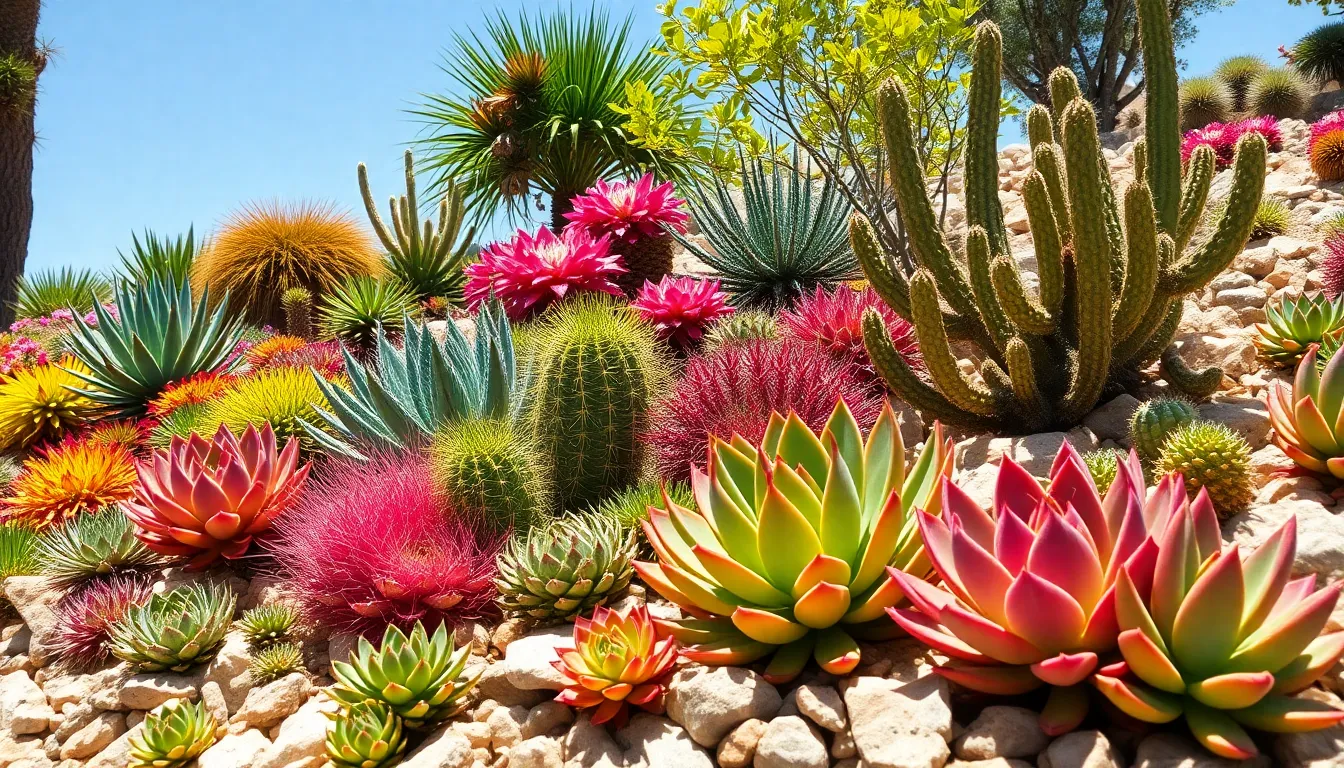
Succulents offer the perfect solution for gardeners seeking stunning plants that require minimal water while thriving in intense heat. These remarkable plants store water in their thick leaves and stems, making them naturally equipped to handle scorching temperatures and extended dry periods.
Sedum Varieties
Sedum varieties excel in full sun conditions and tolerate severe drought better than most traditional garden plants. These hardy succulents come in countless shapes and sizes, from ground-hugging mat-forming types to tall upright specimens that create dramatic focal points. Watering needs become minimal once these plants establish their root systems, typically requiring irrigation only during extended drought periods. Their versatility allows gardeners to use them in rock gardens, containers, green roofs, or as colorful ground covers that spread naturally over time.
Agave Plants
Agave plants represent some of our most reliable choices for extreme heat tolerance and water conservation. Blue Flame Agave and Blue Fox Tail Agave showcase the stunning architectural beauty these plants bring to landscapes while demanding very little care. Deep but infrequent watering sessions work best for agaves, allowing soil to dry completely between applications. Parry’s Agave grows up to 2 feet tall and spreads 3 feet wide, producing fragrant flower spikes that attract beneficial pollinators to your garden. Their slow growth habit means less pruning and maintenance work for busy gardeners.
Prickly Pear Cactus
Prickly Pear Cactus species deliver exceptional drought tolerance while providing unique visual interest through their distinctive pad-shaped segments. These cacti range from compact 12-inch varieties perfect for small spaces to impressive 6-foot specimens that create bold industry statements. Colorful pads and edible fruit add both aesthetic appeal and practical benefits, since the fruit can be harvested for jams and provides natural health benefits like lowering bad cholesterol levels. Wildlife appreciates these cacti too, using them for food sources and shelter throughout the year. Minimal watering requirements make them ideal for gardeners wanting maximum impact with minimal effort.
Incorporate Native Grasses for Natural Landscape Appeal
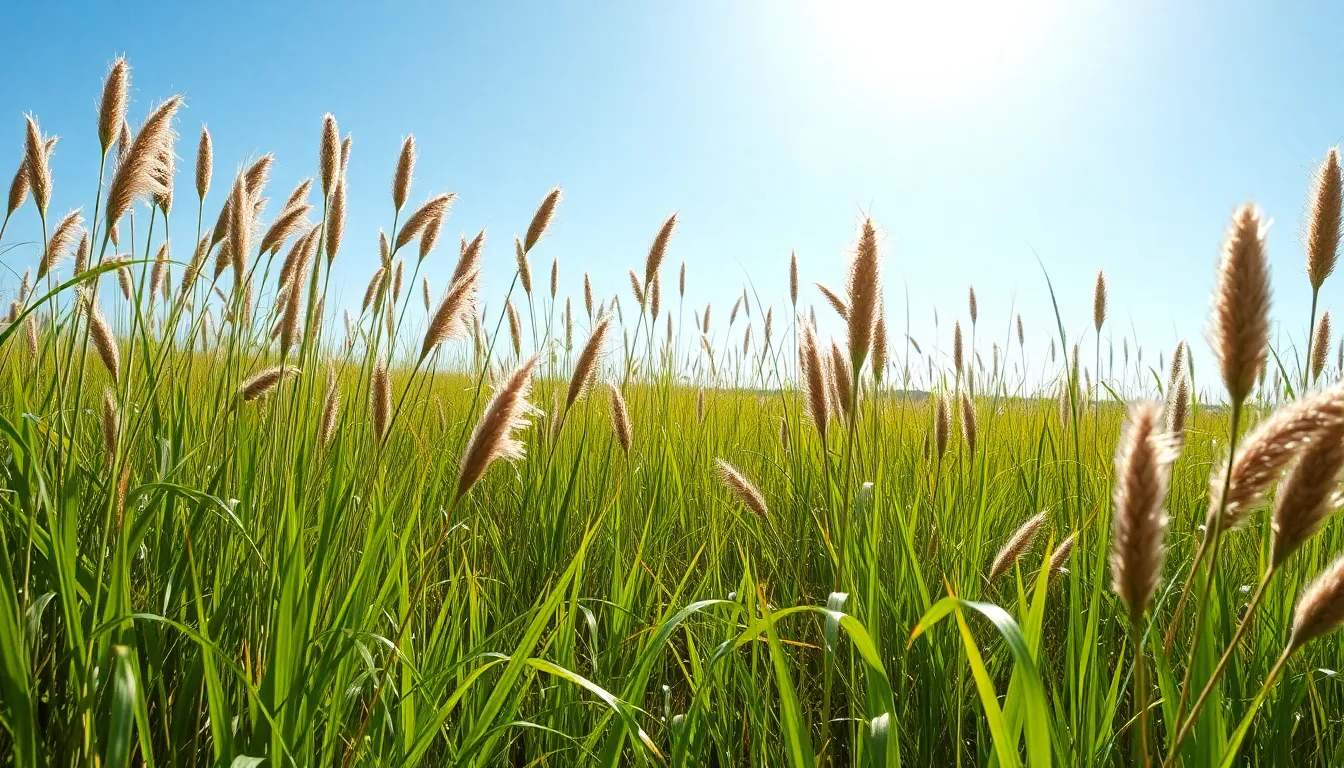
Native grasses offer the perfect solution for creating stunning landscapes that thrive in extreme heat and full sun exposure. These resilient plants provide natural movement and texture while requiring minimal maintenance once established.
Buffalo Grass
Buffalo Grass stands out as one of our top recommendations for hot, sunny lawns and naturalistic landscapes. This warm season native grass forms a dense, low growing turf with fine texture and attractive green gray foliage that transforms to straw colored tones during winter months. Once established, it requires little irrigation, making it perfect for drought prone areas and alkaline soils. We’ve found that Buffalo Grass can withstand poor soil conditions while creating beautiful, functional ground cover that handles foot traffic exceptionally well.
Blue Grama Grass
Blue Grama Grass delivers both beauty and resilience in the harshest full sun conditions. This tough, drought resistant native produces distinctive eyelash shaped seed heads that add remarkable visual interest throughout the growing season. Wildlife benefits tremendously from this grass, as it provides essential habitat and food sources for local ecosystems. We particularly appreciate how Blue Grama adapts to dry, alkaline environments while maintaining its attractive appearance year after year. Naturalistic gardens and prairie style landscapes showcase this grass’s unique characteristics perfectly.
Fountain Grass
Fountain Grass brings graceful movement and soft texture to landscapes exposed to intense heat and full sun. Its arching, fountain like foliage creates stunning visual impact, while the fluffy, bottlebrush flower spikes add seasonal interest and gentle motion in breezes. Varieties like ‘Rubrum’ feature attractive burgundy foliage paired with rosy pink flowers that create dramatic focal points. We recommend Fountain Grass for gardeners seeking ornamental appeal with drought tolerance, as it performs exceptionally well in well drained soils with moderate watering requirements.
Add Colorful Annual Flowers for Seasonal Interest
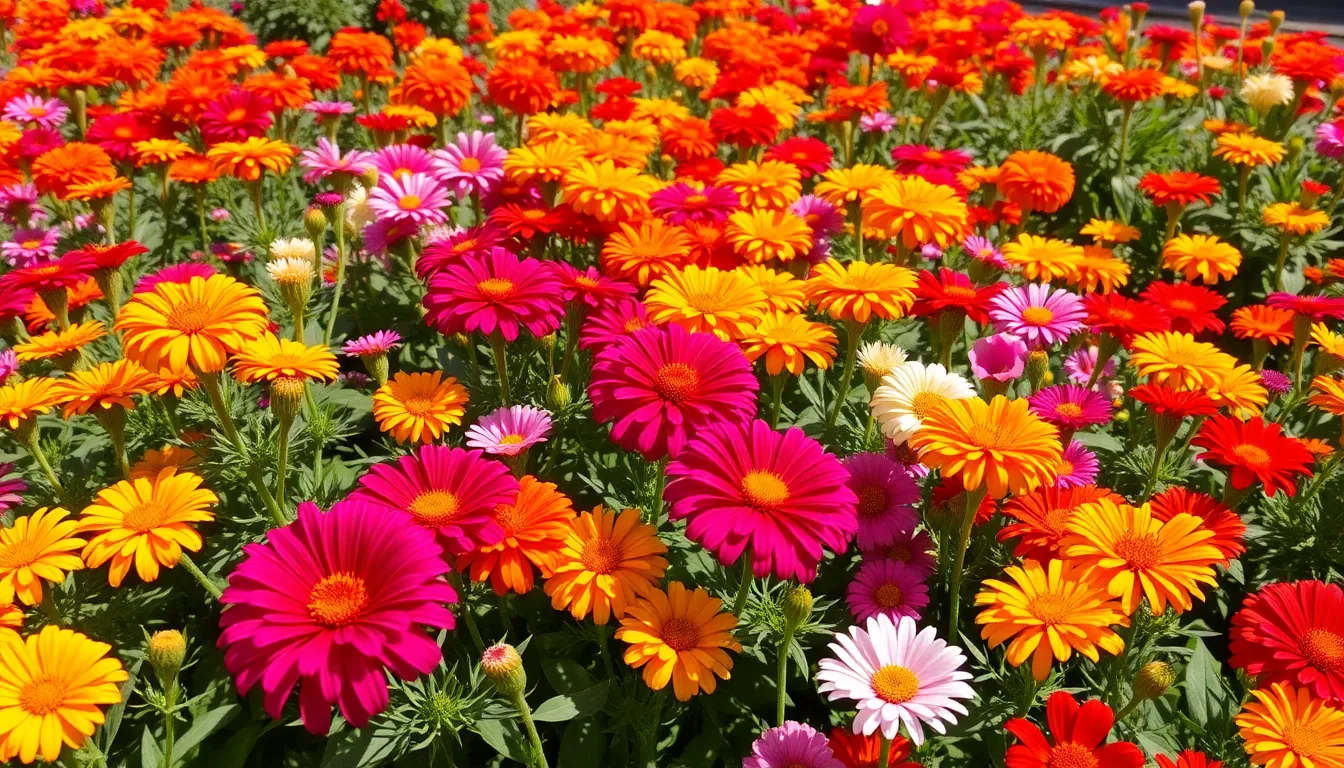
Annual flowers bring instant bursts of color to your hot, sunny garden spaces while providing continuous blooms throughout the growing season. These vibrant performers excel in extreme heat conditions and offer endless opportunities to refresh your industry design each year.
Marigolds
Marigolds deliver brilliant yellow, orange, and red blooms that thrive in the most challenging heat conditions. These hardy annuals flourish in temperatures that would stress other flowering plants, making them our top choice for reliable summer color. We love how they bloom profusely throughout the entire summer season, creating dense carpets of vibrant flowers that never seem to fade.
Their tolerance for dry conditions means you’ll spend less time watering while enjoying maximum visual impact. Marigolds adapt well to poor soil conditions and actually prefer full sun exposure over partial shade locations. These versatile flowers work perfectly in borders, containers, or mass plantings where you need dependable color that lasts.
Zinnias
Zinnias produce an incredible rainbow of flower colors that brighten even the hottest garden spots. These sun loving annuals actually perform better in intense heat than in cooler, milder conditions, making them perfect for challenging climate zones. We appreciate their drought tolerant nature, which allows them to maintain beautiful blooms even during extended dry periods.
Their heavy blooming habit ensures continuous seasonal interest from early summer through the first frost. Zinnias come in various heights and flower forms, giving you flexibility in garden design and arrangement options. These reliable performers require minimal care once established, focusing their energy on producing abundant flowers rather than demanding constant attention.
Portulaca (Moss Rose)
Portulaca thrives in the hottest, driest conditions where other flowers simply cannot survive. This succulent annual stores water in its thick stems and leaves, allowing it to flourish even in poor soil conditions that would challenge most flowering plants. We recommend portulaca for areas that receive intense, direct sunlight throughout the day, as its colorful rose like blossoms actually open best in bright light.
These charming flowers close during cloudy weather and at night, then reopen when the sun returns each morning. Portulaca spreads naturally to form colorful ground cover that requires virtually no maintenance once established. Their ability to thrive in rock gardens, containers, or any well drained location makes them incredibly versatile for hot climate landscaping projects.
Include Mediterranean Herbs for Culinary and Aromatic Benefits
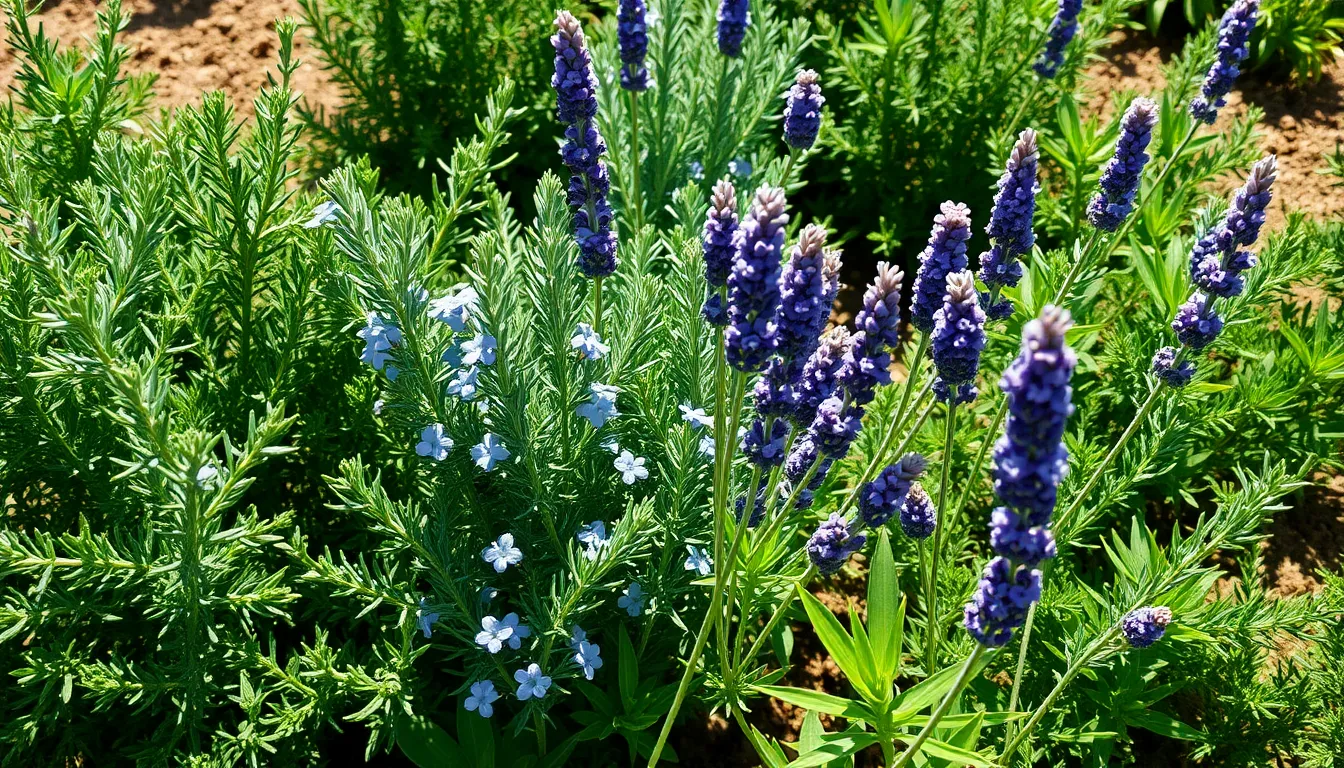
Mediterranean herbs offer exceptional value for full sun gardens, combining heat tolerance with practical culinary and aromatic benefits. These adaptable plants thrive in the same challenging conditions that stress other garden varieties.
Rosemary
Rosemary stands out as a perennial evergreen shrub that grows between 70 to 150 cm tall in full sun conditions. This hardy herb demands lean, well-drained soil and very little water, making it perfectly suited for hot, dry climates. Culinary applications include flavoring dishes like rosemary potatoes and ratatouille, while its needle-like leaves add refreshing notes to grilled foods and beverages such as lemonade. Attractive blue flowers provide additional aesthetic value to gardens, creating visual interest beyond the herb’s practical uses.
Lavender
Lavender thrives in full sun and well-drained soil conditions, delivering both aromatic qualities and culinary versatility. Tiny flowers attract pollinators like bees, improving garden biodiversity while supporting healthy ecosystems. Fragrant flowers and leaves serve multiple purposes in cooking, baking, and herbal tea preparation, plus they’re perfect for creating sachets and essential oils. We recommend lavender for gardeners seeking plants that combine beauty with practical applications.
Oregano
Oregano tolerates heat and sun exceptionally well, requiring minimal water while thriving in hot, dry conditions. This robust Mediterranean herb serves as a staple in many culinary traditions, especially Mediterranean cuisine, adding strong aromatic flavors to sauces, meats, and vegetables. Flowers produced by oregano plants attract beneficial pollinators, supporting garden network health. Growing oregano in full sun locations provides continuous harvests of flavorful leaves throughout the growing season.
| Mediterranean Herb | Height Range | Water Needs | Primary Benefits |
|---|---|---|---|
| Rosemary | 70-150 cm | Very little | Culinary flavoring, blue flowers |
| Lavender | Variable | Minimal | Aromatherapy, pollinator attraction |
| Oregano | Variable | Minimal | Strong culinary flavor, network support |
Plant Heat-Loving Vegetables for Productive Gardens

Heat loving vegetables transform scorching summer conditions into opportunities for abundant harvests. We’ve found that certain vegetable varieties actually perform better in intense heat and full sun than in milder conditions.
Tomatoes
Tomatoes require full sun exposure and warm temperatures to produce their most abundant fruit yields. We recommend selecting heat tolerant varieties that thrive when daytime temperatures exceed 85°F and nighttime temperatures remain above 60°F. Well drained soil becomes essential for preventing root rot in hot conditions, as waterlogged roots combined with extreme heat can quickly damage plants. Popular heat resistant varieties like Phoenix, Homestead 24, and Stupice consistently outperform standard cultivars in scorching climates. These plants actually need the intense solar energy to develop their sugars properly, resulting in more flavorful tomatoes than those grown in cooler conditions.
Peppers
Peppers thrive in hot weather conditions that would stress many other vegetables, making them perfect companions for sun drenched gardens. We’ve observed that both sweet and hot pepper varieties require similar growing conditions to tomatoes, including full sun exposure and temperatures consistently above 70°F. Hot peppers like jalapeños, habaneros, and cayennes develop their signature heat levels only when grown in intense sunlight and warm soil. Sweet pepper varieties such as bell peppers and Italian frying peppers also benefit from hot conditions, producing thicker walls and more vibrant colors. These plants continue producing throughout the summer heat when many other vegetables begin to decline.
Okra
Okra loves full sun and warm soil conditions, producing tender pods even when temperatures soar above 95°F. We consider this vegetable one of the most heat tolerant options for summer gardens, as it actually becomes more productive as temperatures rise. The plant requires soil temperatures above 65°F for proper germination and thrives in hot summer conditions that would wilt other crops. Popular varieties like Clemson Spineless and Burgundy continue producing pods throughout the hottest months, often yielding harvests every other day during peak season. This remarkable vegetable needs minimal water once established, making it ideal for drought prone areas where consistent irrigation becomes challenging.
Consider Ornamental Trees and Shrubs for Structure
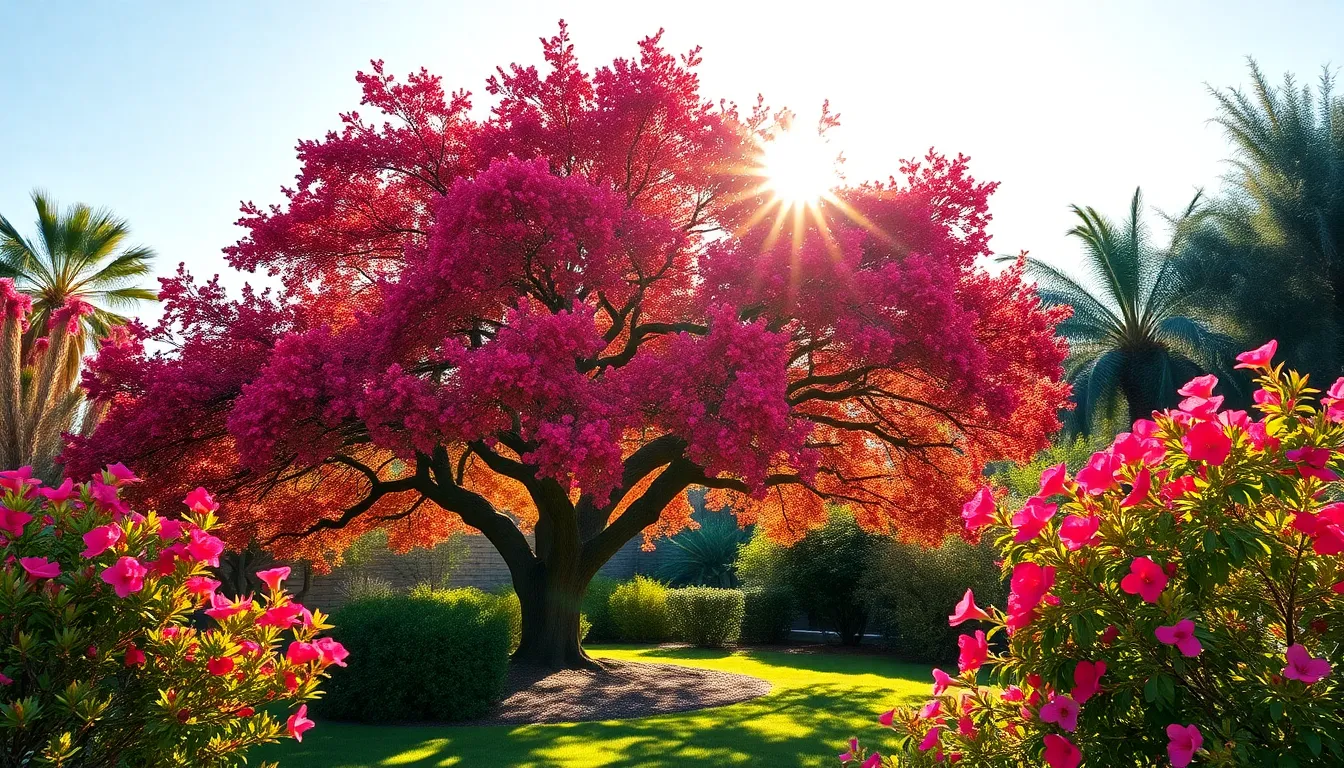
We often overlook the importance of structural plants when designing heat-tolerant gardens. These larger specimens provide essential shade, visual interest, and framework that make our full sun gardens both functional and beautiful.
Texas Red Oak
Texas Red Oak (Quercus buckleyi) stands as one of our top choices for creating natural shade in hot climate gardens. This native oak tree adapts exceptionally well to scorching temperatures and direct sunlight, making it perfect for regions with intense summer heat. Once established, it becomes remarkably drought tolerant, requiring minimal irrigation even during extended dry periods.
We love how this oak provides important shade coverage while adding spectacular seasonal interest. The vibrant red fall foliage creates a stunning focal point that brightens our autumn industry. Its deep root system helps it withstand both heat and drought conditions, making it a reliable long-term investment for our garden structure.
Barberry Shrubs
Barberry shrubs (Berberis spp.) offer us incredible versatility for full sun heat gardens with their dense foliage and vibrant color options. These hardy shrubs thrive in intense sunlight and high temperatures, providing consistent performance throughout the hottest months. Their foliage ranges from deep greens to brilliant reds and rich purples, giving us many design possibilities.
We appreciate how drought tolerant these shrubs become once established, reducing our watering needs significantly. Barberry plants create excellent natural barriers while maintaining their attractive appearance even in challenging growing conditions. Their compact growth habit makes them ideal for both formal and informal industry designs in hot climate gardens.
Oleander
Oleander (Nerium oleander) delivers exceptional beauty and heat tolerance for our full sun gardens. This remarkable shrub not only withstands extreme heat but actually flourishes in intense sunlight conditions. We can count on oleander to produce abundant, often fragrant flowers throughout the summer months when many other plants struggle.
Its outstanding drought and heat tolerance makes oleander one of our most reliable choices for low maintenance landscaping. The profuse summer blooms create continuous color displays that enhance our garden’s visual appeal. We find oleander particularly valuable because it maintains its lush appearance even during the most challenging weather conditions, requiring minimal care while delivering maximum impact.
Establish Ground Cover Plants for Low-Maintenance Areas
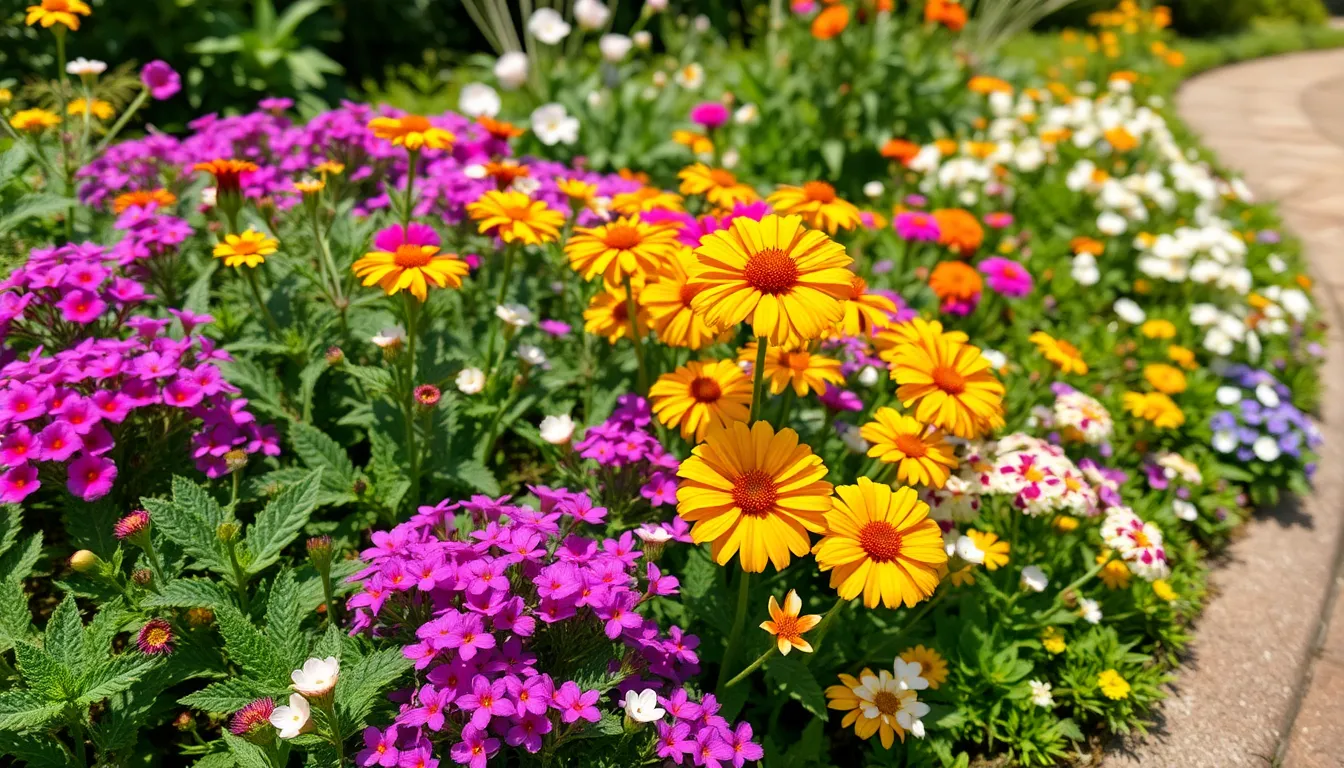
Ground cover plants create stunning carpets of color while suppressing weeds and reducing garden maintenance needs. These spreading beauties thrive in full sun conditions and handle extreme heat with remarkable resilience.
Lantana
Lantana produces vibrant flower clusters that create spectacular displays throughout the hottest months of summer. This heat loving ground cover attracts butterflies and bees with its continuous blooms in shades of yellow, orange, red, and purple. We recommend planting lantana in well drained soil where it’ll spread naturally to cover large areas with minimal intervention. Once established, this drought tolerant beauty requires little to no supplemental watering, making it perfect for slopes and challenging sunny locations. Gardeners appreciate how lantana’s dense growth pattern naturally suppresses weeds while providing months of colorful interest.
Ice Plant
Ice plant delivers brilliant daisy like flowers that bloom profusely across succulent foliage designed for extreme conditions. This remarkable ground cover thrives in full sun and well drained soil, producing bright blooms in pink, purple, yellow, and white throughout the growing season. We’ve found ice plant particularly valuable for rock gardens, slopes, and areas with poor soil where other plants struggle to establish. The succulent nature of ice plant means it stores water in its leaves, requiring minimal irrigation once established. Delosperma species spread quickly to form dense mats that prevent erosion while adding spectacular color to challenging landscapes.
Creeping Phlox
Creeping phlox transforms sunny areas into stunning floral carpets that bloom profusely in late spring and early summer. This low growing perennial spreads naturally to cover large spaces with flowers in pink, purple, and white that attract butterflies and other beneficial pollinators. We recommend planting creeping phlox in well drained, loamy soil where it’ll establish quickly and return year after year with increasing coverage. During drought periods, weekly watering helps maintain optimal flowering, though this hardy ground cover tolerates heat stress better than most alternatives. Rock gardens and slopes benefit tremendously from creeping phlox’s ability to prevent soil erosion while creating breathtaking seasonal displays.
Conclusion
Creating a stunning heat-tolerant garden doesn’t have to be overwhelming when you know which plants will thrive in challenging conditions. We’ve covered everything from drought-resistant perennials and colorful annuals to productive vegetables and structural elements that’ll transform your industry.
By choosing the right combination of plants for your exact needs you’ll build a garden that’s not only beautiful but also sustainable and low-maintenance. These heat-loving varieties will reward you with vibrant colors abundant harvests and year-round interest while requiring minimal water and care.
Your summer garden can be the envy of the neighborhood with these proven performers that actually love the heat.
Frequently Asked Questions
What are the best heat-tolerant perennials for hot climate gardens?
The top heat-tolerant perennials include Black-Eyed Susan, Purple Coneflower, and Blanket Flower. These plants provide long-lasting beauty with vibrant blooms while requiring minimal maintenance. They’re perfect for creating stunning landscapes that thrive in extreme temperatures and return year after year, making them excellent investments for hot climate gardening.
Which drought-resistant succulents work best in extreme heat?
Sedum and Agave are excellent drought-resistant succulents for extreme heat conditions. These plants store water in their leaves, making them incredibly resilient during hot, dry periods. They require minimal watering and maintenance while adding unique textures and architectural interest to your garden design.
What native grasses thrive in hot, sunny conditions?
Buffalo Grass and Blue Grama Grass are outstanding native grass options for hot climates. These grasses are naturally adapted to extreme heat and drought conditions, requiring less water and maintenance than traditional lawn grasses. They create beautiful, sustainable landscapes while supporting local ecosystems and wildlife.
Which annual flowers add color to hot summer gardens?
Marigolds, Zinnias, and Portulaca are excellent annual flowers for hot summer gardens. These colorful blooms thrive in intense sunlight and high temperatures, providing continuous seasonal interest. They’re easy to grow, require minimal care, and offer vibrant colors that enhance any garden’s aesthetic appeal throughout the summer months.
What Mediterranean herbs combine heat tolerance with culinary benefits?
Rosemary, lavender, and oregano are perfect Mediterranean herbs for hot climates. These aromatic plants not only survive extreme heat but actually prefer sunny, dry conditions. They provide fresh herbs for cooking while adding fragrance and beauty to your garden, making them both practical and decorative choices.
Which heat-loving vegetables produce well in scorching conditions?
Tomatoes (varieties like Phoenix and Homestead 24), peppers, and okra are excellent heat-loving vegetables. These crops actually thrive in high temperatures and intense sunlight, producing abundant harvests throughout the summer. They’re ideal for gardeners wanting fresh produce despite challenging hot weather conditions.
What ornamental trees and shrubs provide structure in heat-tolerant gardens?
Texas Red Oak, Barberry shrubs, and Oleander are excellent structural plants for hot climates. These plants offer shade, visual interest, and seasonal beauty while tolerating extreme heat and drought conditions. They create garden framework and provide year-round appeal with minimal water requirements and maintenance needs.
Which ground cover plants work best in sunny, challenging locations?
Lantana, Ice Plant, and Creeping Phlox are ideal ground covers for hot, sunny areas. These plants create colorful carpets while suppressing weeds and reducing maintenance. They thrive in poor soil conditions and intense heat, making them perfect for challenging locations where other plants might struggle to survive.

